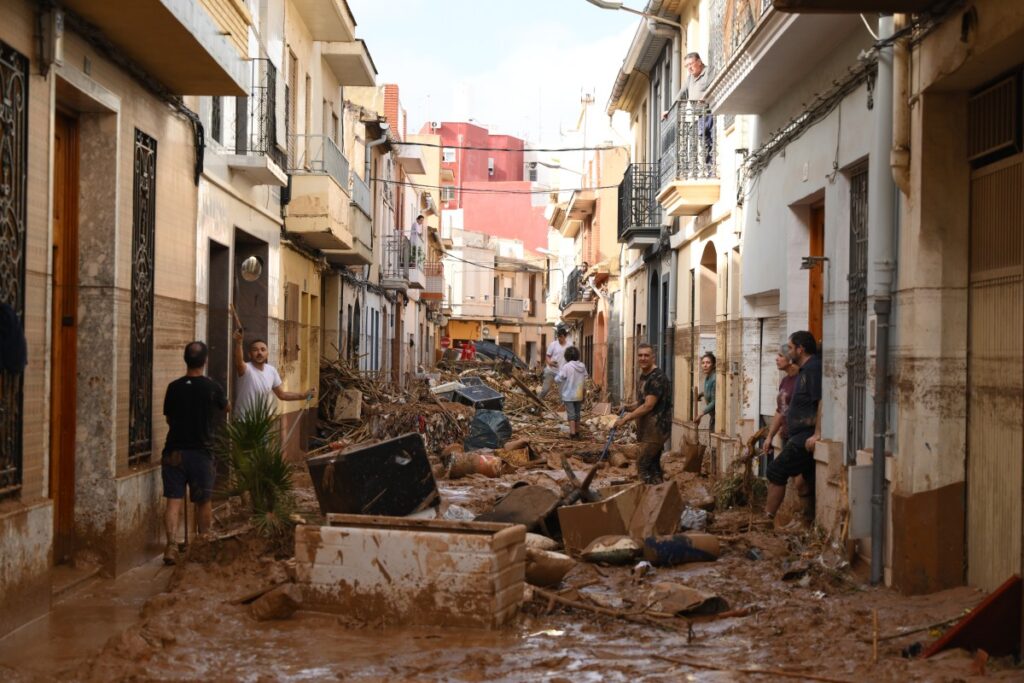The Mediterranean coastline has been witness to the growing impact of extreme weather events. From the flooding of the Turia River in 1957 to the current tragedy in the same region, climate change has emerged as a key factor in the shift from “cold drops” to increasingly persistent DANAs. .
October 1957, city of Valencia: torrential rains caused the River Turia to overflow its banks, leaving the city flooded and more than 80 people dead. After the tragedy – known in popular memory as the riuà – the Plan Sur was launched, a pharaonic infrastructure to divert the riverbed away from the city center and make it capable of withstanding a larger volume of water.
September 1962, Vallès Occidental, Barcelona province: excessive rainfall on the night of the 25th caused the Llobregat, Ripoll and Besòs rivers to burst their banks, causing devastating floods and leaving massive destruction in their wake. The number of victims, estimated at between 600 and 1,000, was never determined. The lack of urban planning highlighted the inequality, as many of the dead lived in shantytown conditions in flood-prone areas such as the riverbanks.
October 1970: a “cold drop” episode brought heavy rains to the region of Murcia and Almería, causing rivers to burst their banks. Approximately 20 deaths were recorded. September 1996: torrential rains caused flooding in Almeria, affecting several localities. At least 8 people died.
In the 20th century, the German School of Meteorology coined the term “kaltlufttropfen”, translated as “cold air drop”. The concept reached Spain and became widely known as “gota fría”, especially to refer to these torrential rains and even, on occasions, to the resulting floods. The expert José Antonio Fernández Monistrol pointed out that “in Spanish, the expression gota fría came to be distorted and associated with any type of situation of abundant rainfall. The term DANA (Depresión Aislada en Niveles Altos) is currently used instead of the term ‘gota fría’ (cold drop), which has been widely and sometimes erroneously used”. Since the 2000s, with the turn of the century, the more precise and technical term DANA become popular, and its official and scientific use is now widely accepted. However, the DANA is now in the eye of the storm for reactionaries, as the ultra-right-wing climate change deniers refuse not only to use the term, but also to accept the scientific evidence that this phenomenon will become increasingly recurrent and destructive.
October 2024, Valencia´s metropolitan area: early in the morning of the 29th, the State Meteorological Agency (AEMET) declared a red alert level in several areas of Valencia. It was not until after eight o’clock in the evening that Civil Protection, which is ” the regional government’s responsibility”, issued a massive alert. By that time, the floods had already inundated part of the territory. So far, official figures state that more than 200 people have died, and the search for the missing is still ongoing.
The diversion of the Turia riverbed, after the South Plan was carried out for the riuà, prevents the flooding of the city of Valencia. The towns impacted by the hydraulic structure are now those in the south of the metropolis, which, with the industrial boom between the 1960s and 1980s, experienced an increase in population in search of work in manufacturing and commercial sectors. The southern metropolitan belt, which has a working-class profile and includes towns such as Sedaví, Benetússer, Alfafar and Massanassa, has been the main victim of the DANA.
What we talk about when we talk about DANA
A DANA is a meteorological phenomenon that occurs when a mass of cold air breaks away from the main atmospheric currents and becomes “trapped” at high altitudes in the atmosphere. As meteorologist Mar Gómez explains graphically in ElTiempo, these storms occur when the polar jet stream, which normally moves from west to east, begins to undulate and form curves, “these ‘shapes’ isolate a part of this circulation as if it were a small pocket outside the atmosphere’s own circulation”, she explains. This causes instability, especially if this cold air mass meets warmer and more humid air at low levels, as it is often the case in areas close to the Mediterranean.
Territory and seasonality make for an explosive scenario
As experts in the field have been pointing out for years, the Western Mediterranean has one of the highest flood risk levels in Europe. María del Carmen Llasat Botija, Professor of Atmospheric Physics in the Department of Applied Physics at the University of Barcelona, analyses the idiosyncrasies of the territory in the report Flood risk in Spain: analysis and solutions for the generation of resilient territories. “The Mediterranean is a warm and almost closed sea, surrounded by an orography characterised by a notable mountainous relief. It favours cyclogenesis and the existence of an air mass with high humidity, instability and latent energy, with the consequent development of adverse weather episodes such as flash floods or strong windstorms,” she explains. “All of this makes weather forecasting, and therefore climate prediction, more complicated than usual,” adds Llasat Botija on the erratic factor that this entails.
The explosion of hydrometeorological phenomena in the territory is closely related to seasonal conditions and local temperatures. In the study, the professor points out that convective rains – which occur when warm air rises and forms clouds – are characteristic of summer and early autumn, due to the heat and atmospheric instability that prevail at this time. In the Mediterranean region, these rains tend to be brief and localised in summer. But in autumn, the intensity of rainfall can become alarmingly pronounced when sea waters reach higher temperatures and atmospheric activity increases, alongside the appearance of phenomena such as cyclones. This confluence of factors can lead to catastrophic weather events, causing much heavier and prolonged rainfall, leading to flooding and other serious problems for affected communities.
The weather emergency, catalyst for the DANA (and those to come)
The alteration of the global hydrological cycle, as pointed out by the Intergovernmental Panel on Climate Change, is changing the distribution and frequency of rainfall and droughts around the world. This change represents an unprecedented challenge, as hundreds of millions of people are forced to adapt to water conditions that were unknown until just a few decades ago, and lack the historical perspective needed to understand these impacts. In turn, the climate emergency is also having a negative effect on weather cycles. In this context, AEMET meteorologist Enrique Fernández Barrera highlights in an informative article that climate change can influence three key factors that favour the formation of a DANA: “the contribution of humidity, which can be favoured by a warmer Mediterranean or by a greater inflow of humid subtropical air; greater instability in jet streams; and changes in weather patterns on a larger scale”.
According to the International Union for Conservation of Nature (IUCN), the increase in temperature in the Mediterranean is advancing 20% faster than the global average, This is leading to an increase in water evaporation and, therefore, in atmospheric humidity. According to the Clausius-Clapeyron equation, for every degree increase in temperature, the air can hold 7% more water vapour. More unstable conditions are generated and the stars align for the formation of Isolated High Level Depressions (ILD). The combination of elevated temperatures and increased moisture loading increases the risk of severe flooding in the region, exacerbating the strength of these storms.
The impact of anthropogenic climate change makes the world more hostile to humans. Populist and reactionary discourses attempt to discredit the scientific evidence; warnings about the increased persistence and intensity of DANAs are met with a return to “kaltlufttropfen”, because, as some “nostalgic sectors” would say, “the good old days were better”. These instrumentalisation tactics aim to undermine public confidence in scientific institutions by prioritising the production cycle and minimising the relevance of available data. This undermining of credibility allows reactionary governments to avoid adapting infrastructures and protocols to increasingly extreme climatic conditions. With no prevention management and a subsequent intervention that leaves much to be desired, there is still no calm in the southern metropolitan belt after the storm.



